Insects Pests of Vegetable Crops HORT 378 Integrated
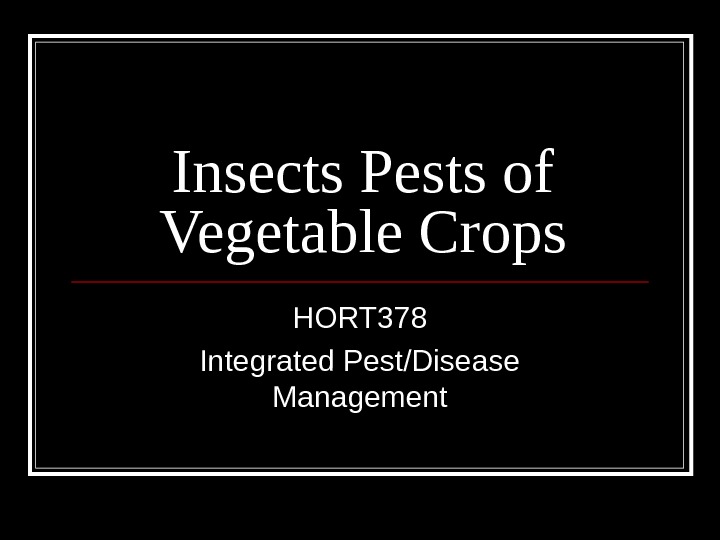
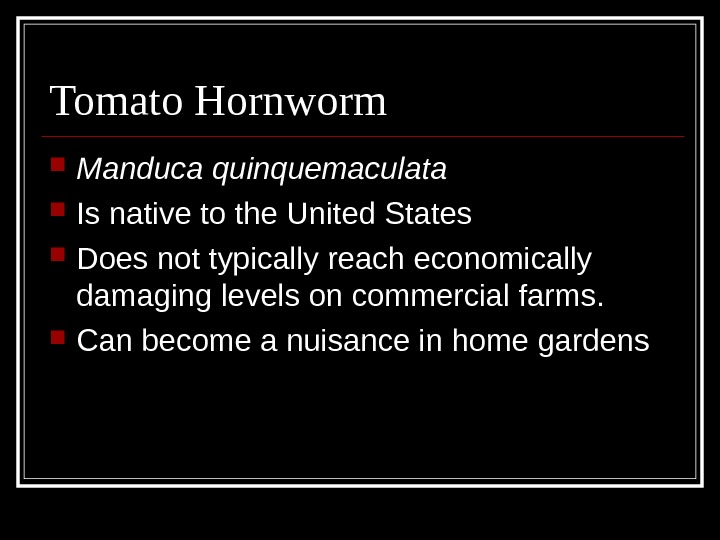
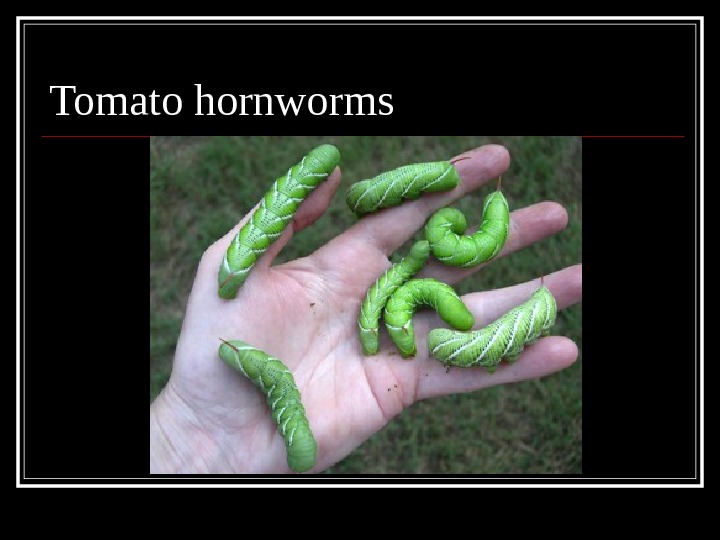
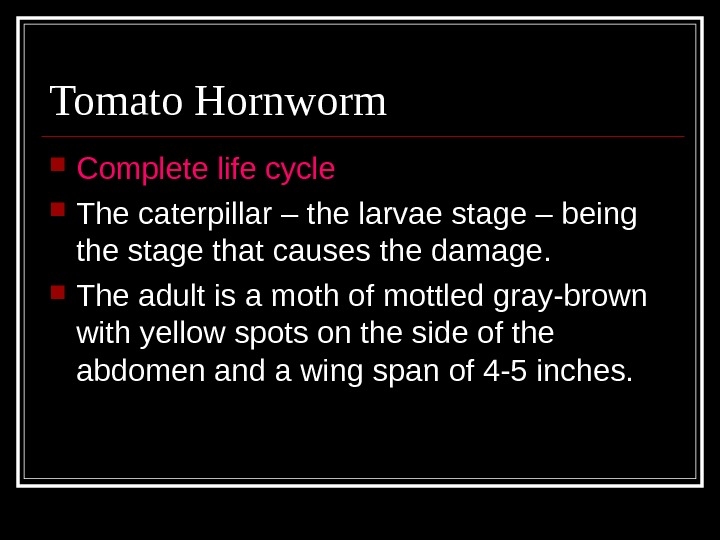
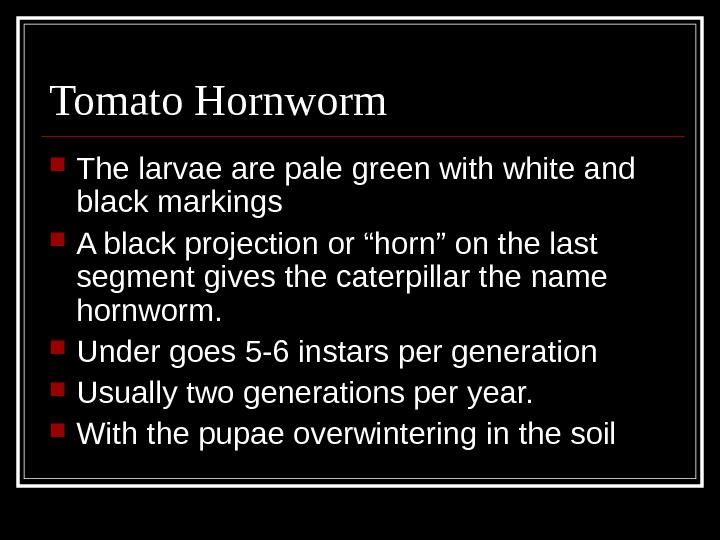
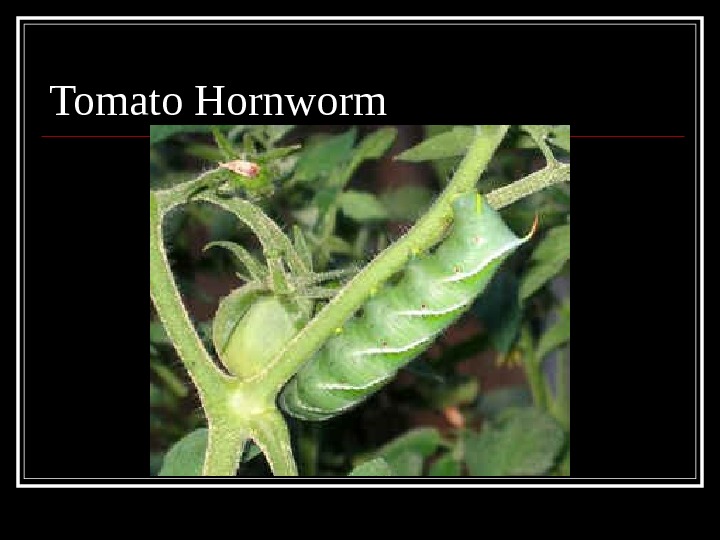
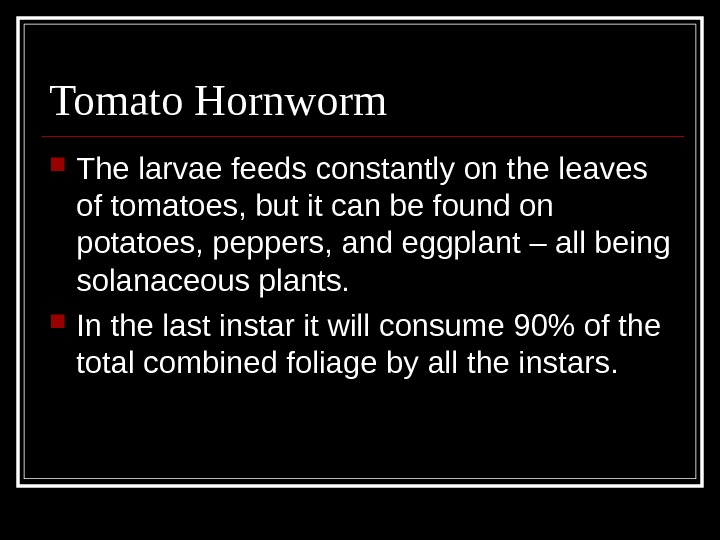
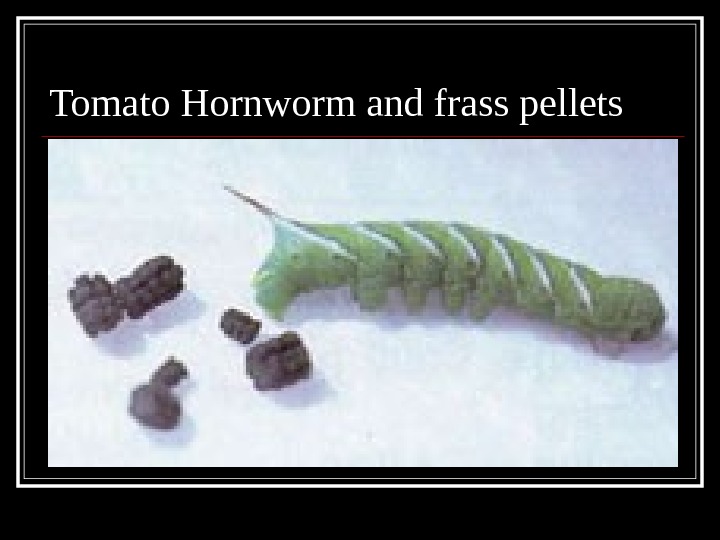

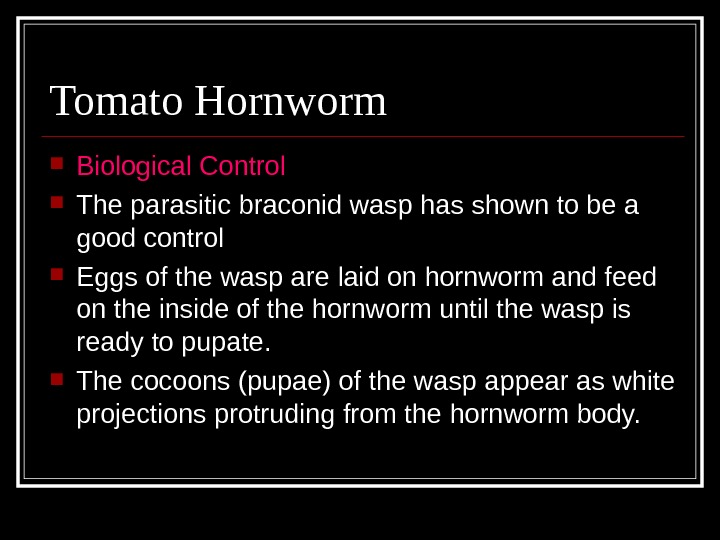
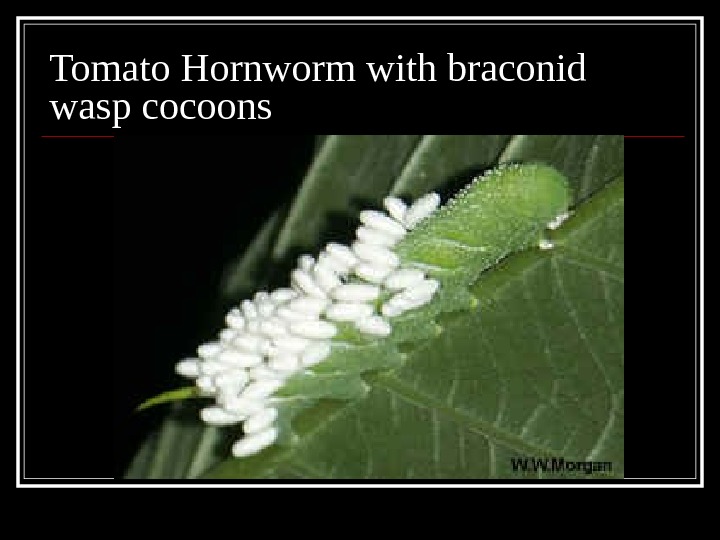
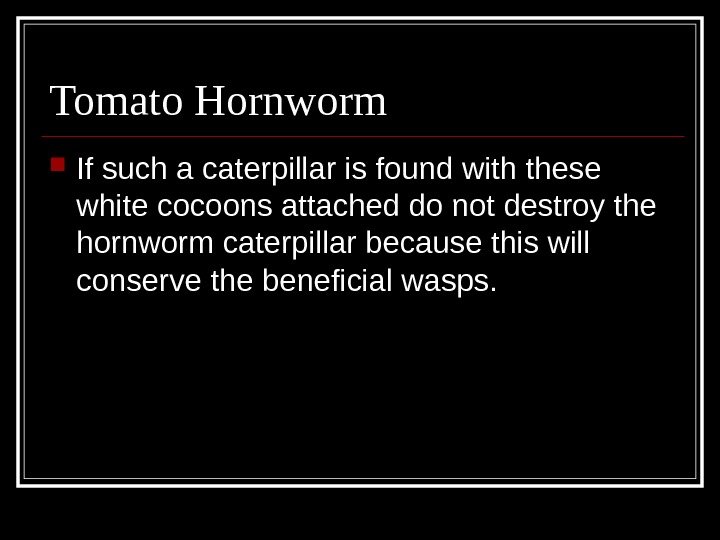
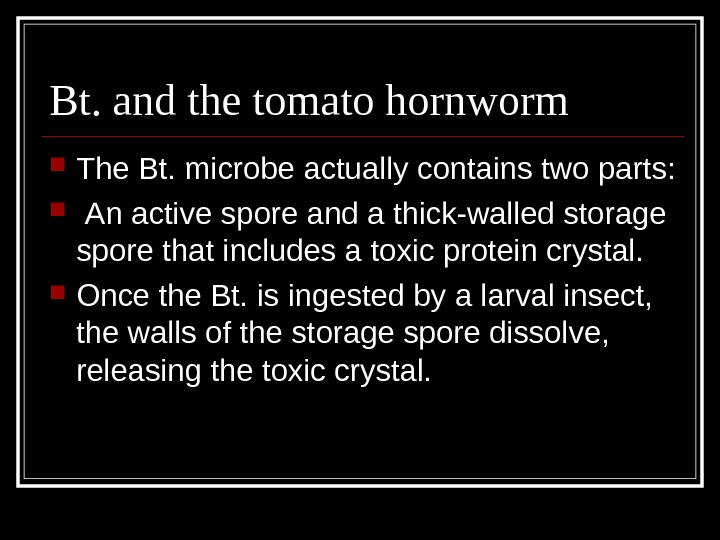
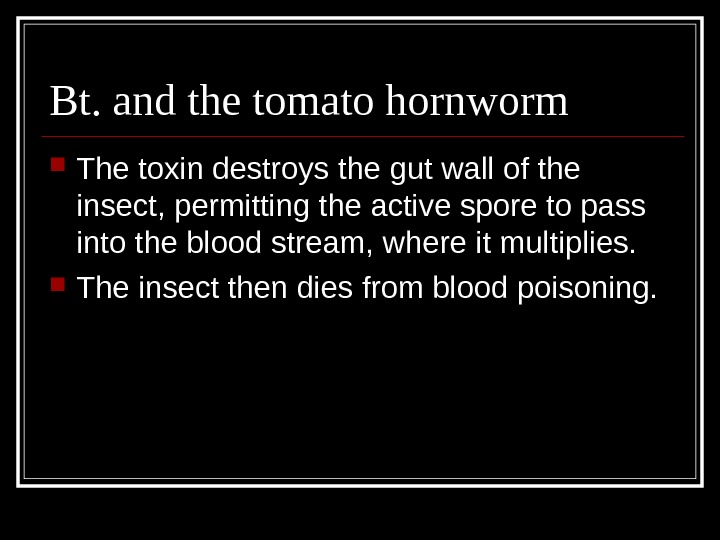
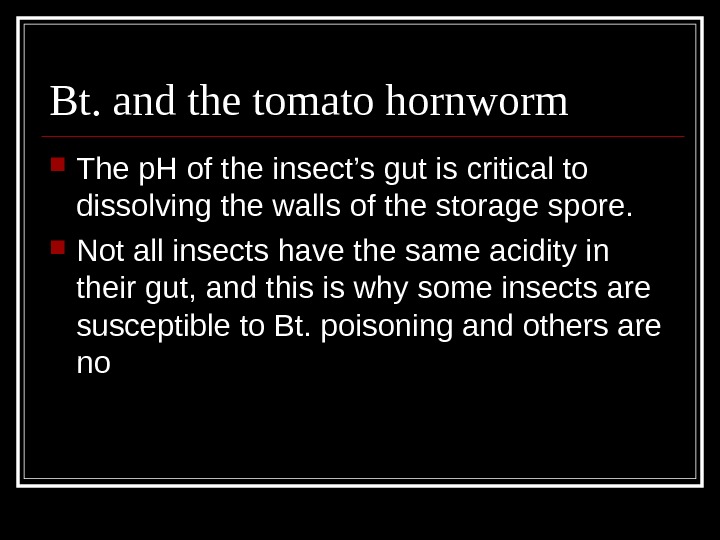
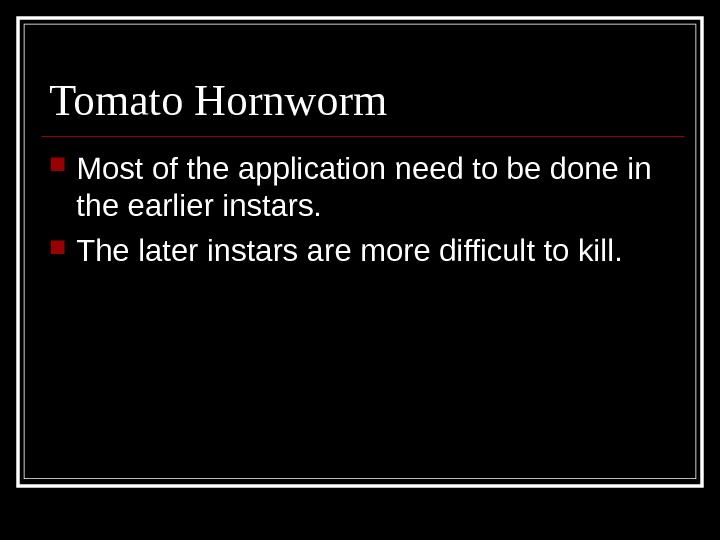
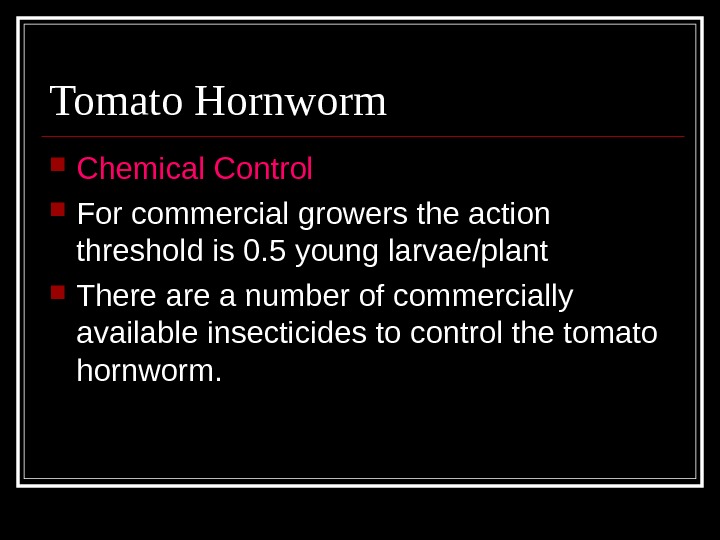
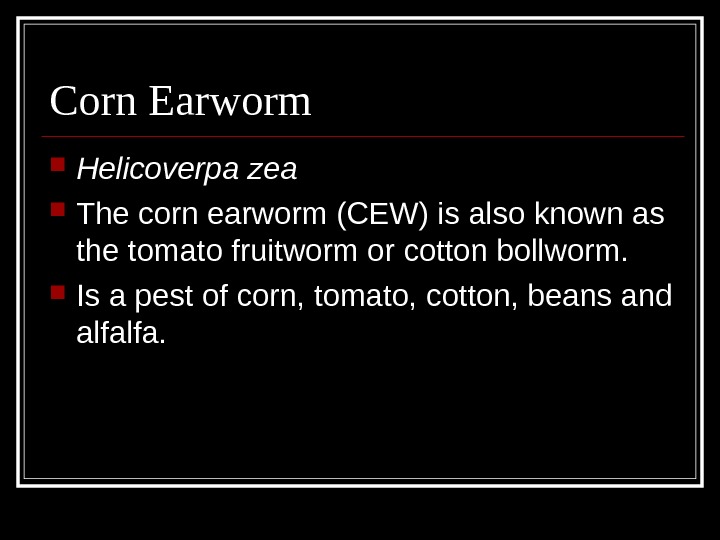
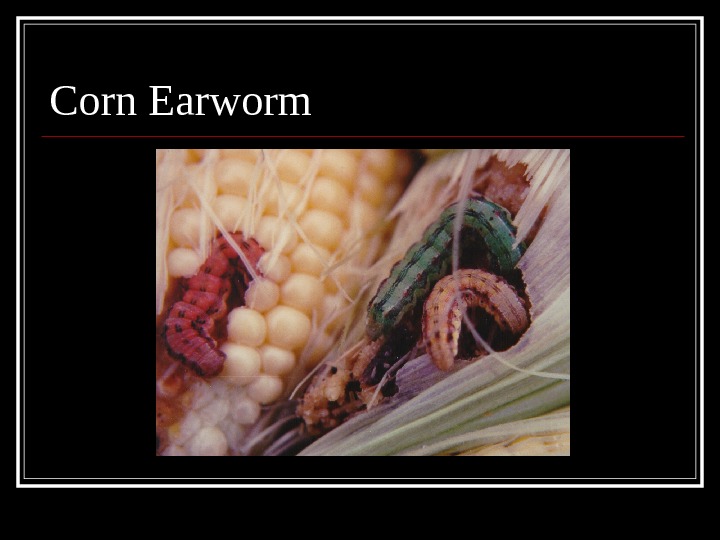
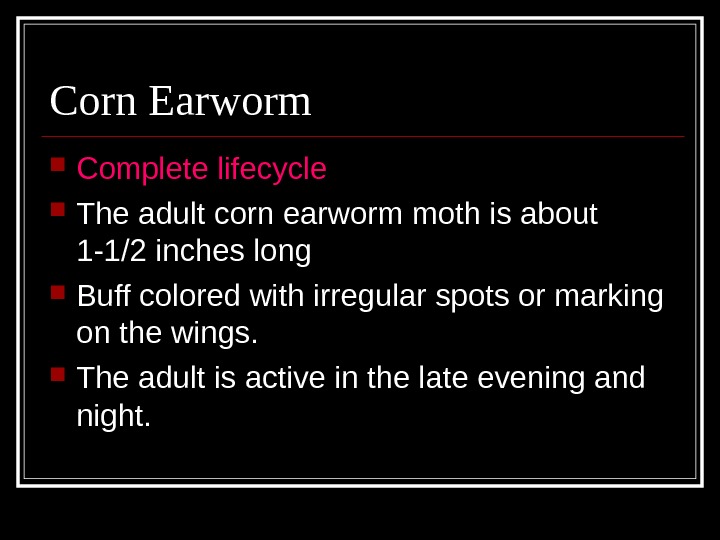
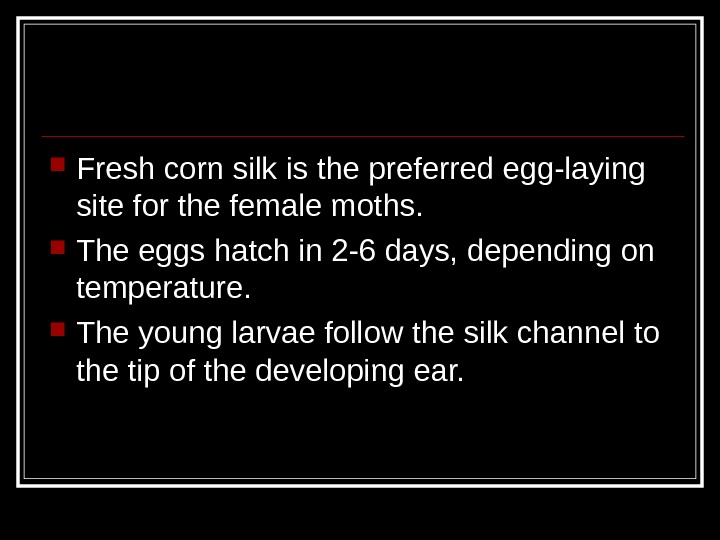
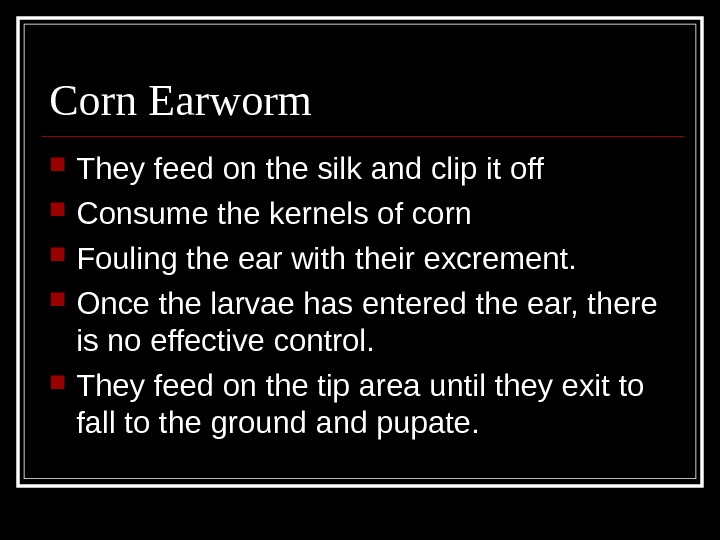
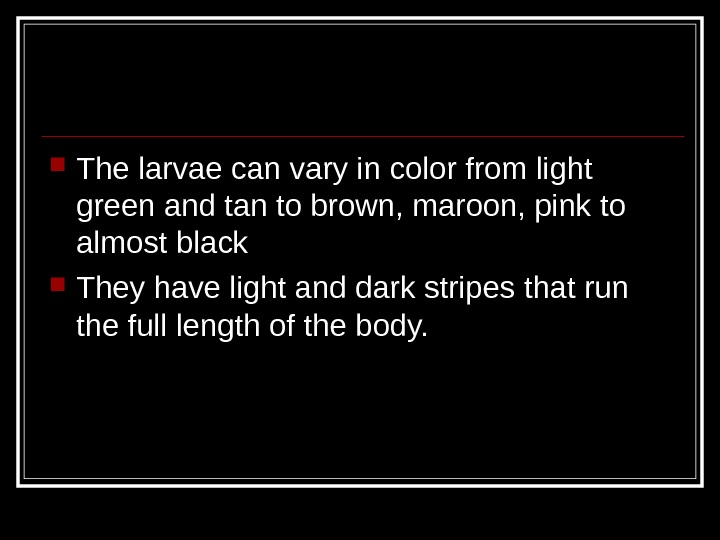

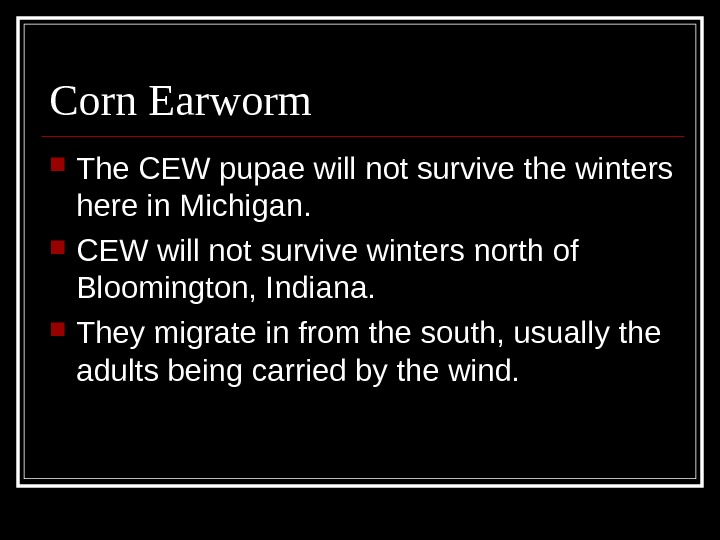

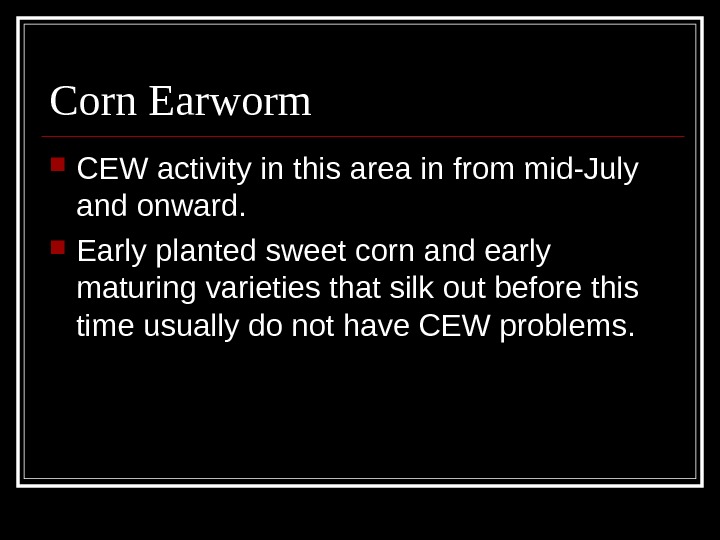
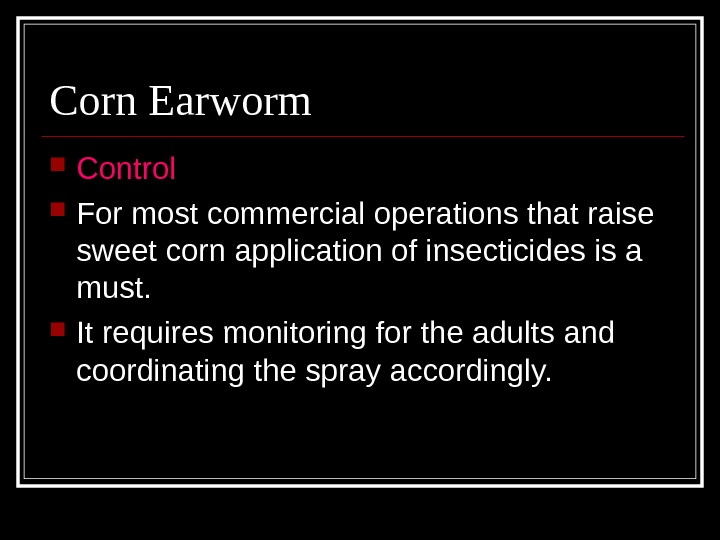
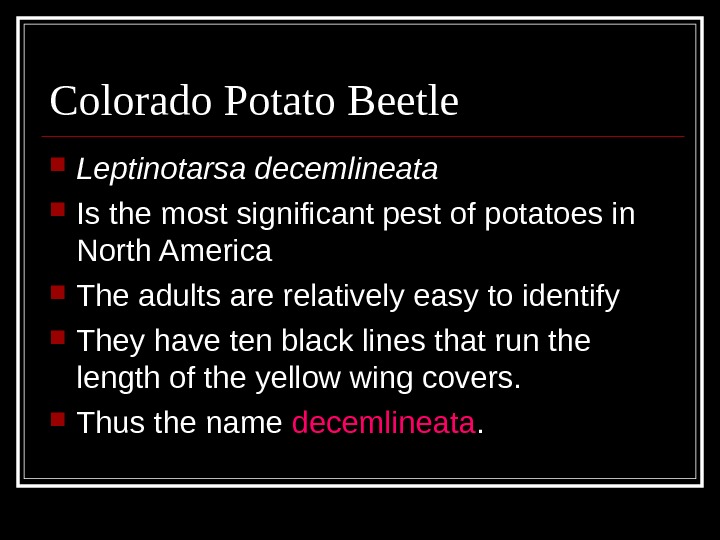
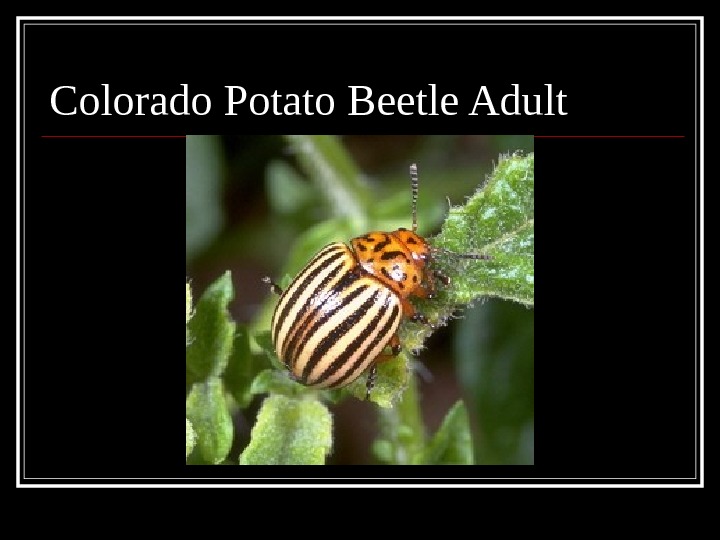
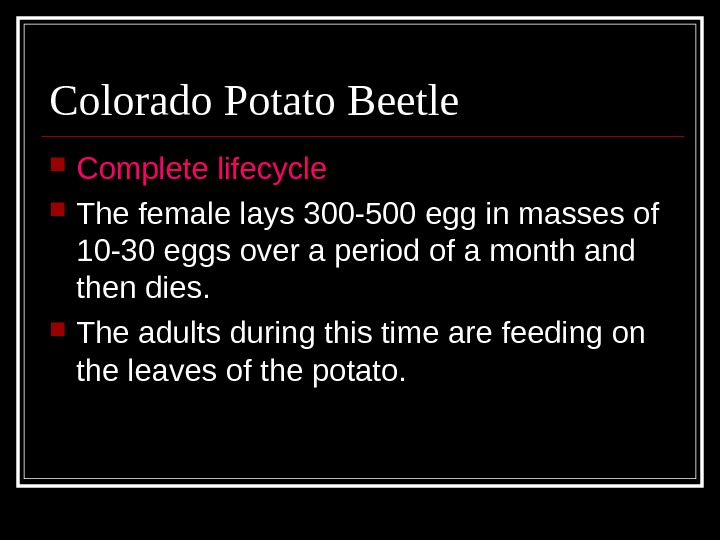
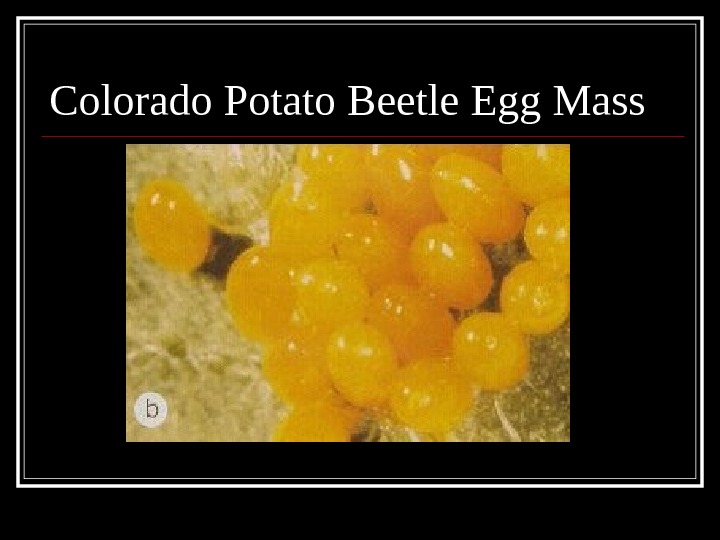
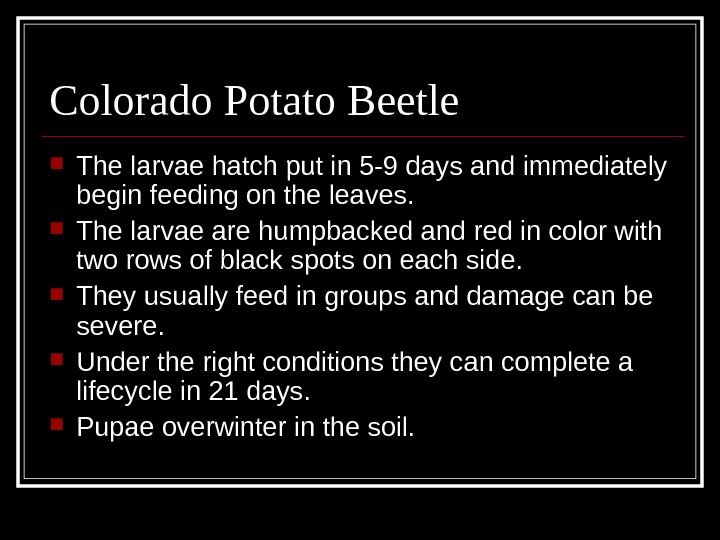
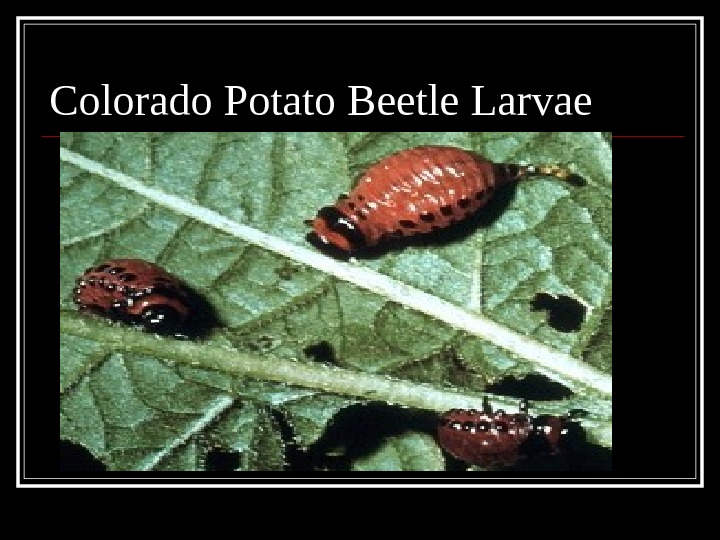
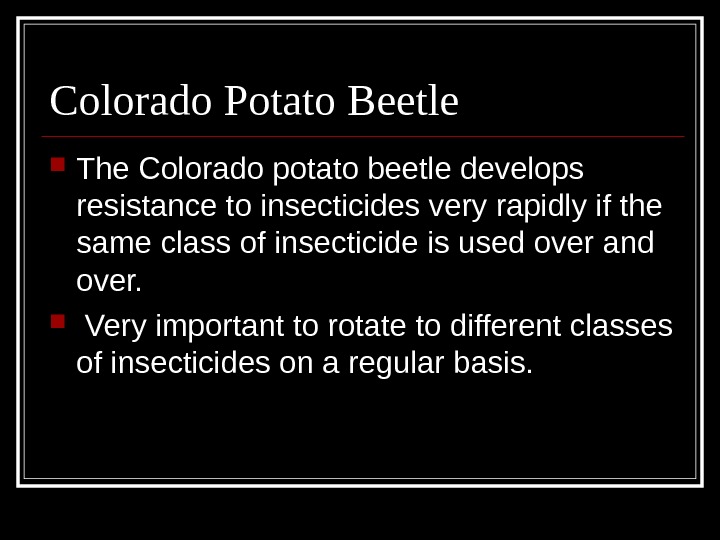
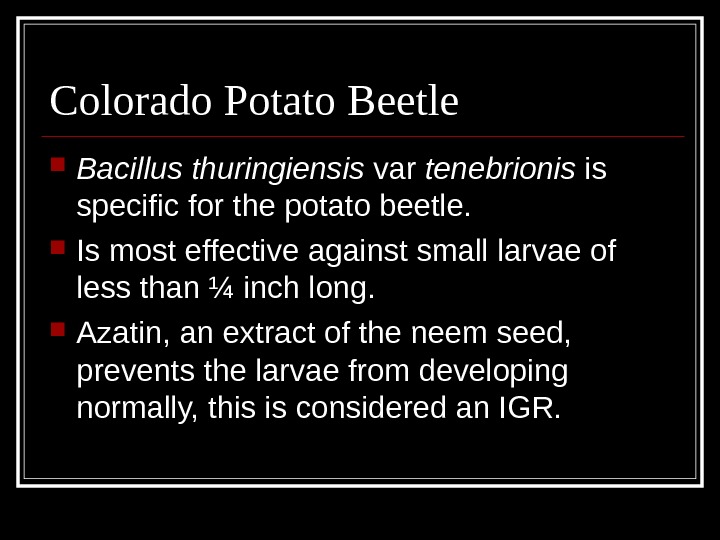
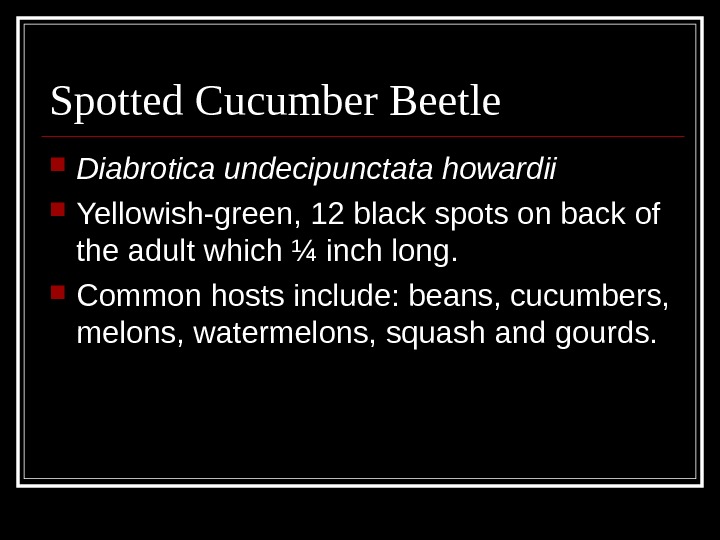
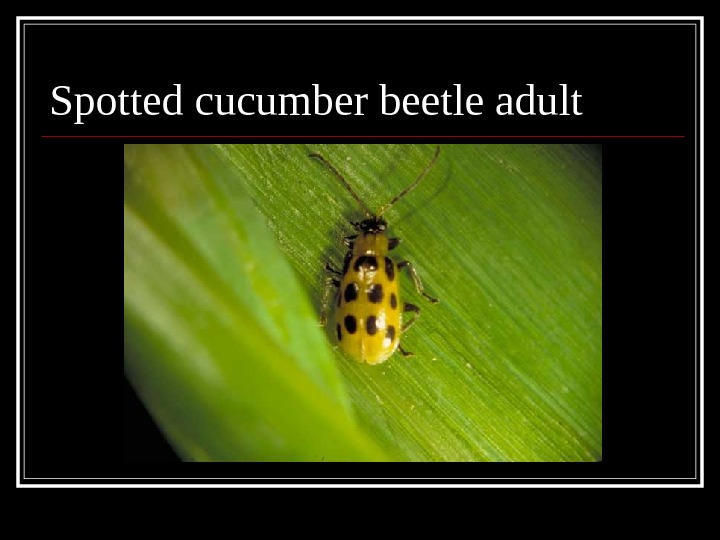
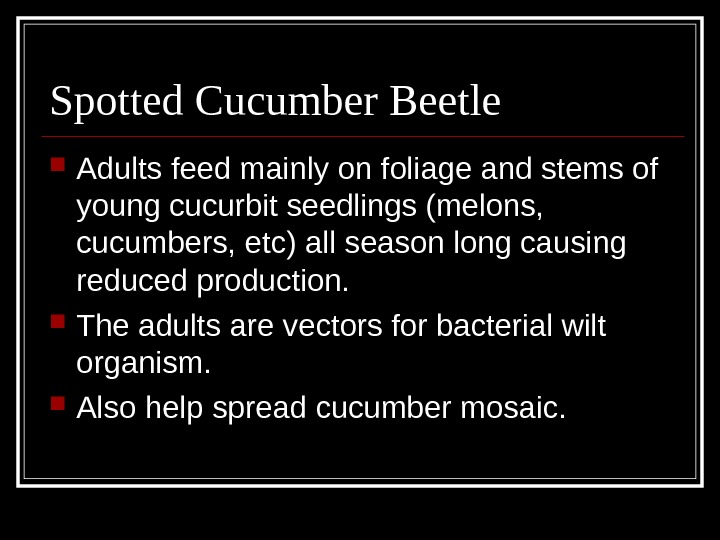
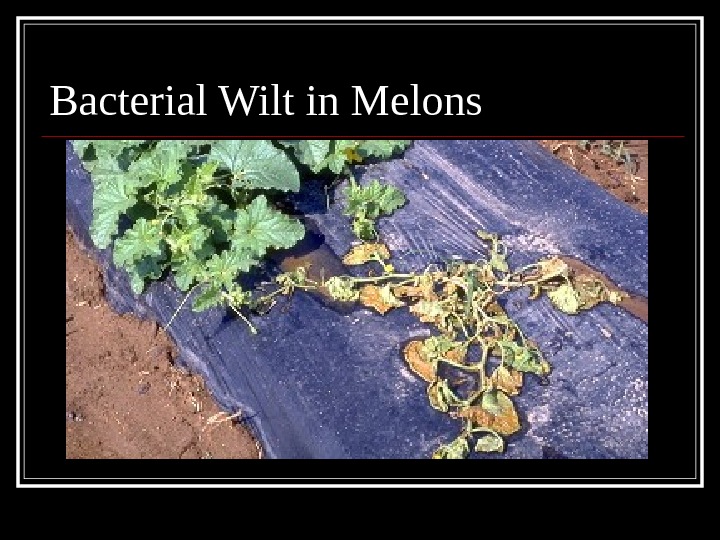
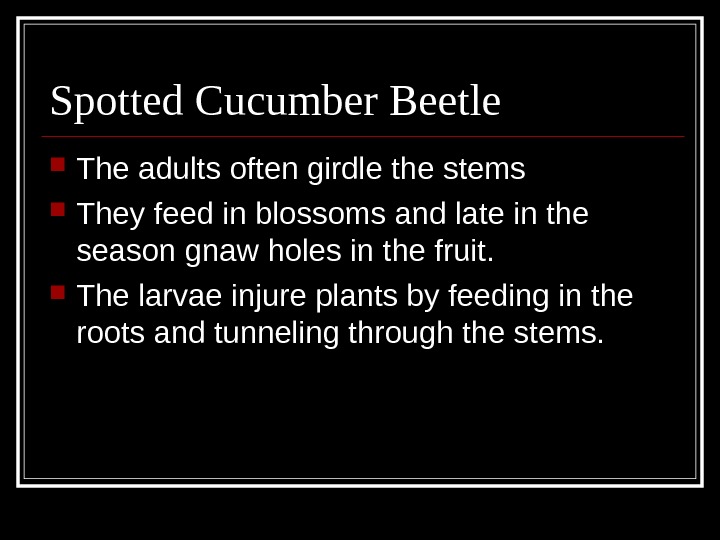
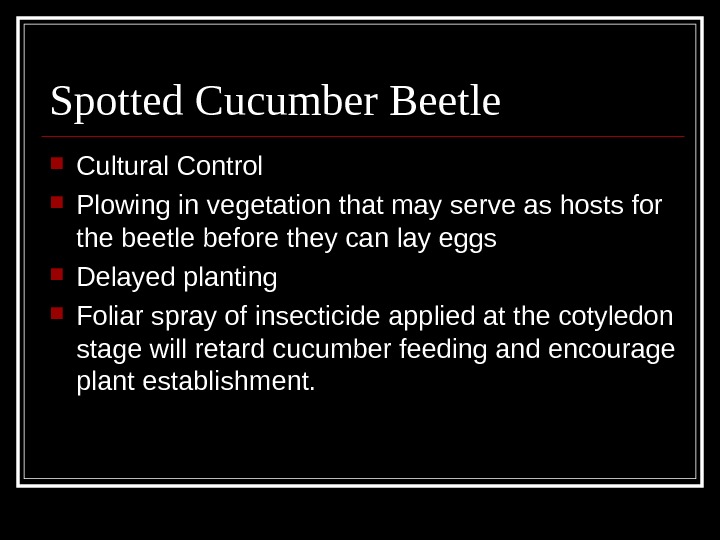
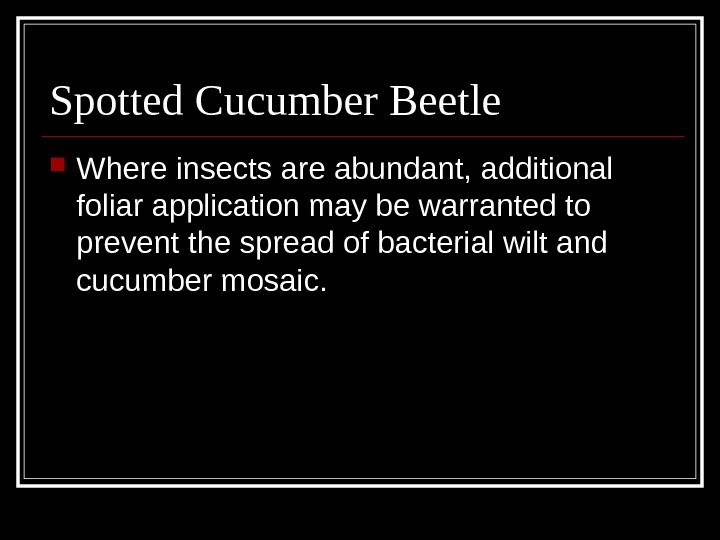
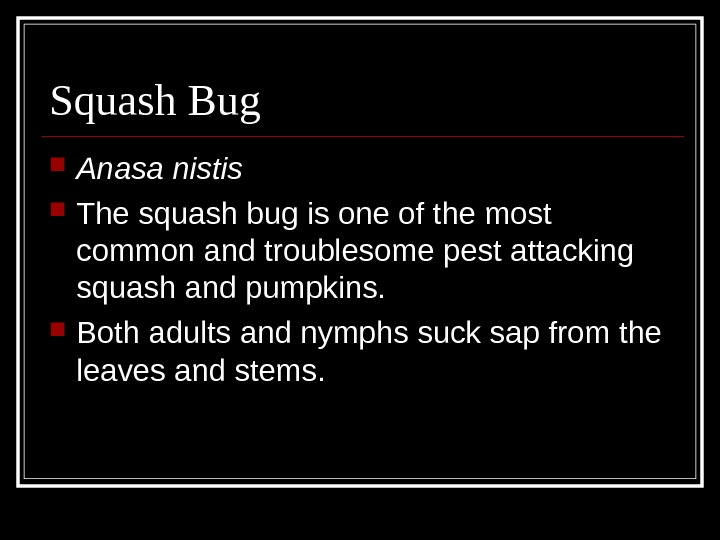
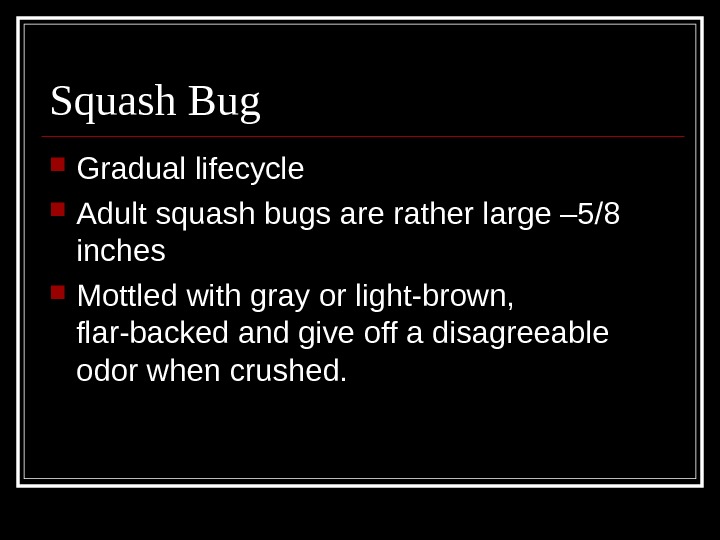
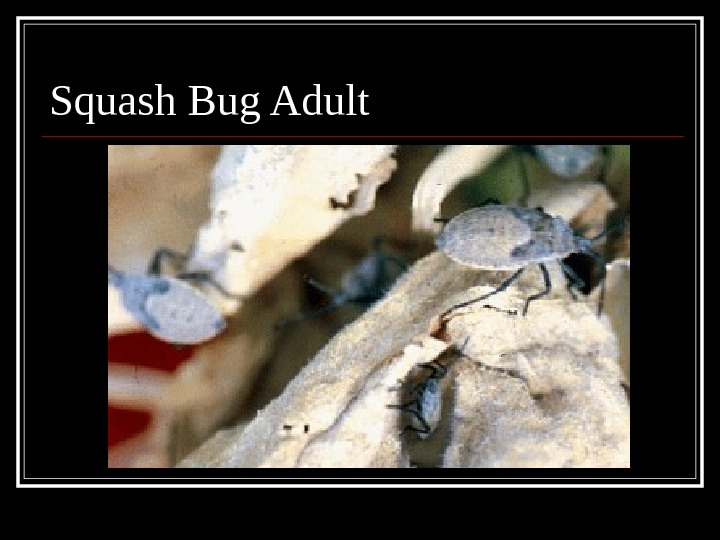
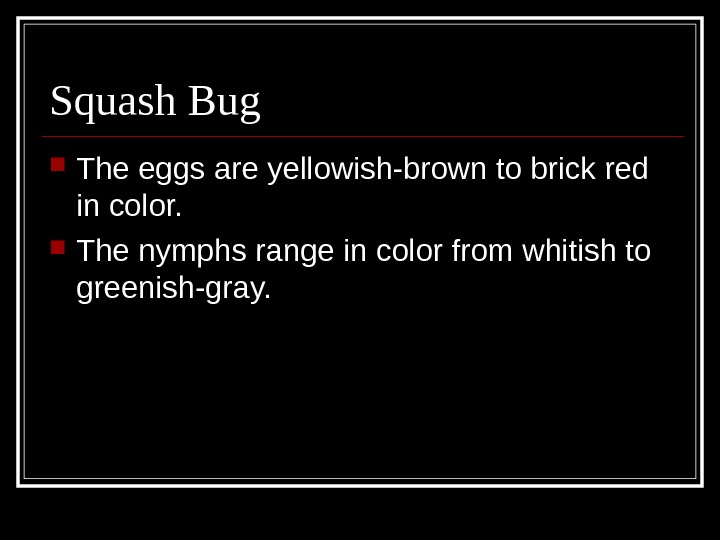
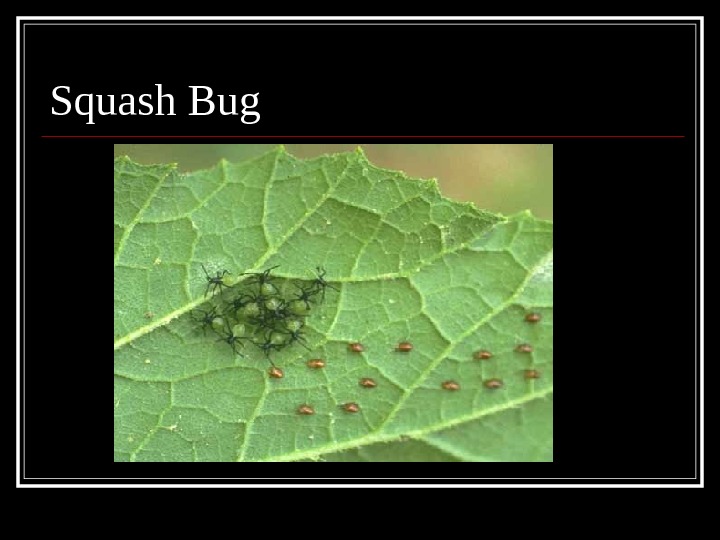
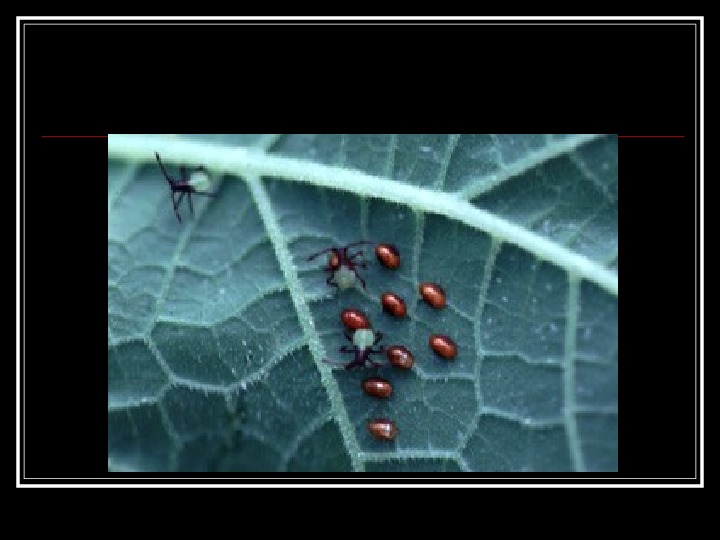
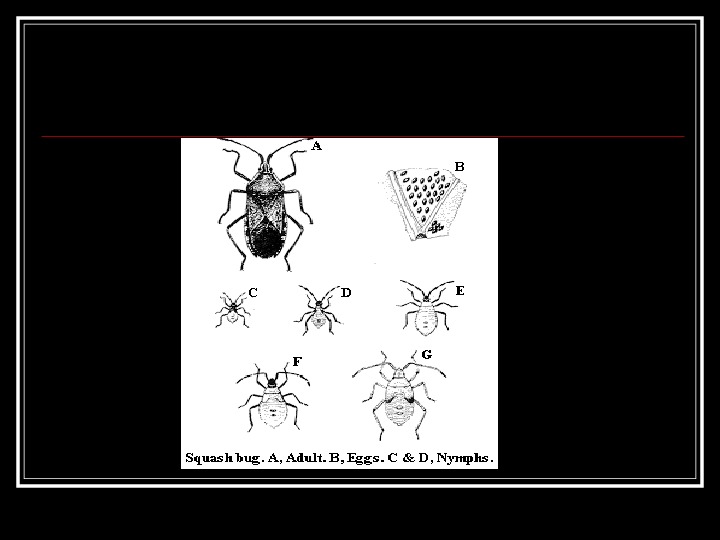
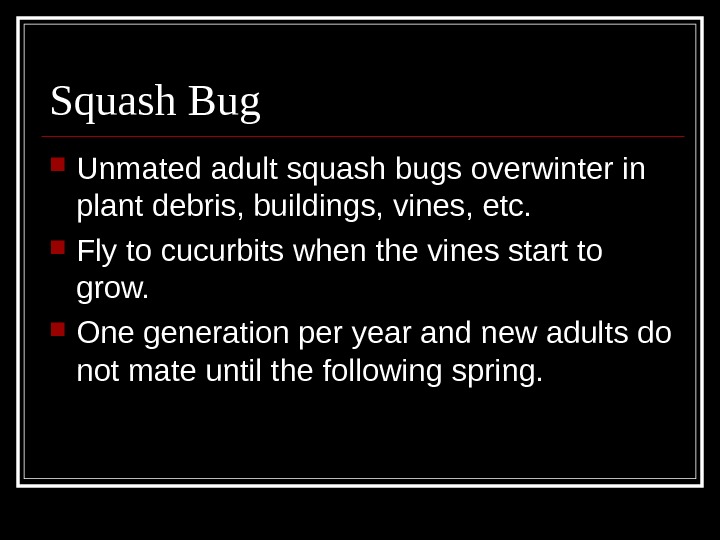
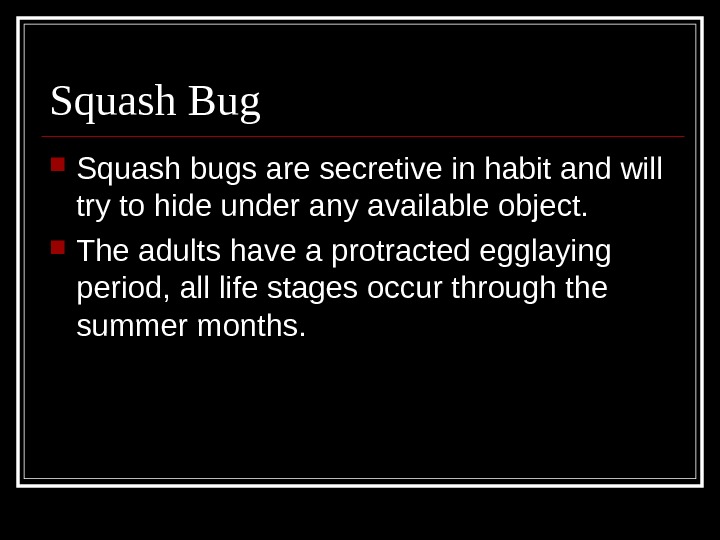
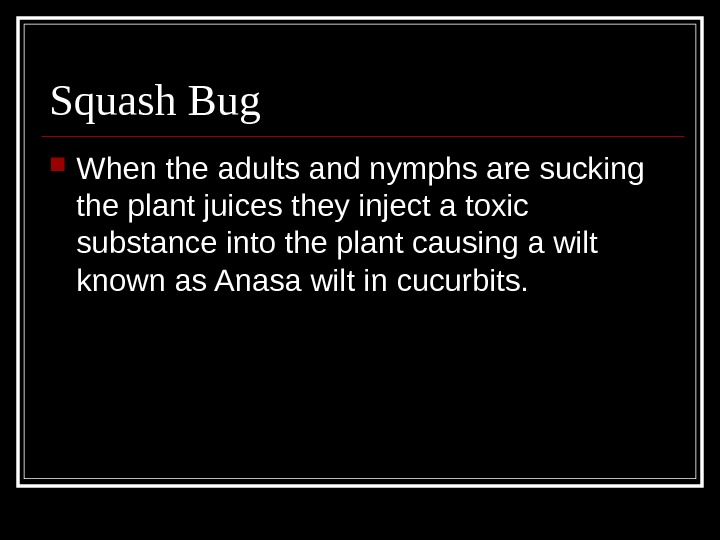
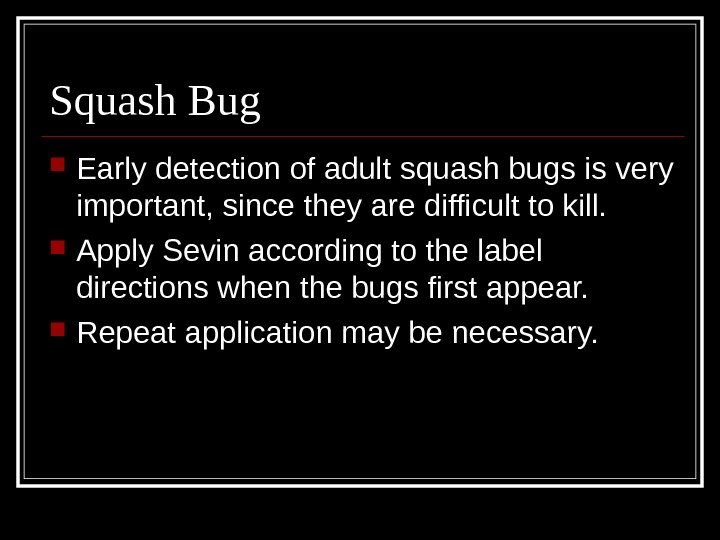

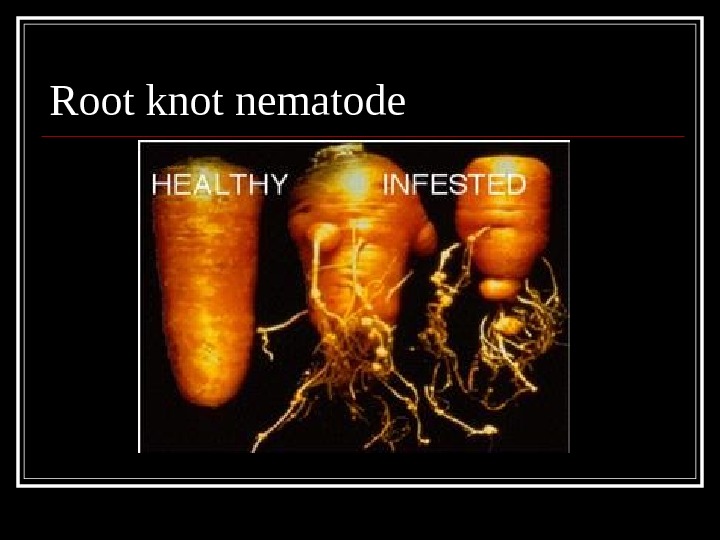
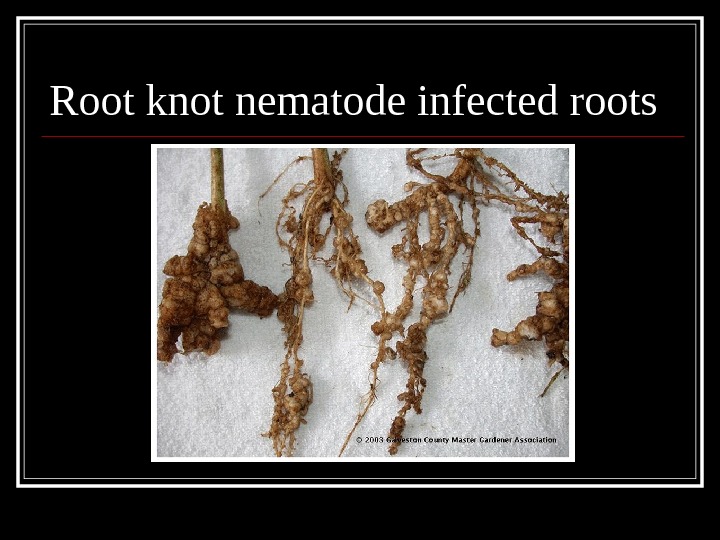
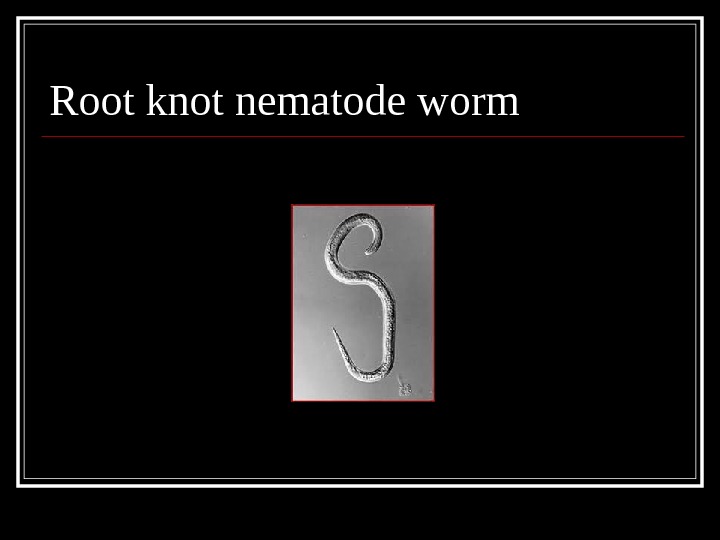
insects_pests_of_vegetable_crops.ppt
- Размер: 1.6 Mегабайта
- Количество слайдов: 58
Описание презентации Insects Pests of Vegetable Crops HORT 378 Integrated по слайдам
 Insects Pests of Vegetable Crops HORT 378 Integrated Pest/Disease Management
Insects Pests of Vegetable Crops HORT 378 Integrated Pest/Disease Management
 Tomato Hornworm Manduca quinquemaculata Is native to the United States Does not typically reach economically damaging levels on commercial farms. Can become a nuisance in home gardens
Tomato Hornworm Manduca quinquemaculata Is native to the United States Does not typically reach economically damaging levels on commercial farms. Can become a nuisance in home gardens
 Tomato hornworms
Tomato hornworms
 Tomato Hornworm Complete life cycle The caterpillar – the larvae stage – being the stage that causes the damage. The adult is a moth of mottled gray-brown with yellow spots on the side of the abdomen and a wing span of 4 -5 inches.
Tomato Hornworm Complete life cycle The caterpillar – the larvae stage – being the stage that causes the damage. The adult is a moth of mottled gray-brown with yellow spots on the side of the abdomen and a wing span of 4 -5 inches.
 Tomato Hornworm The larvae are pale green with white and black markings A black projection or “horn” on the last segment gives the caterpillar the name hornworm. Under goes 5 -6 instars per generation Usually two generations per year. With the pupae overwintering in the soil
Tomato Hornworm The larvae are pale green with white and black markings A black projection or “horn” on the last segment gives the caterpillar the name hornworm. Under goes 5 -6 instars per generation Usually two generations per year. With the pupae overwintering in the soil
 Tomato Hornworm
Tomato Hornworm
 Tomato Hornworm The larvae feeds constantly on the leaves of tomatoes, but it can be found on potatoes, peppers, and eggplant – all being solanaceous plants. In the last instar it will consume 90% of the total combined foliage by all the instars.
Tomato Hornworm The larvae feeds constantly on the leaves of tomatoes, but it can be found on potatoes, peppers, and eggplant – all being solanaceous plants. In the last instar it will consume 90% of the total combined foliage by all the instars.
 Tomato Hornworm and frass pellets
Tomato Hornworm and frass pellets
 Tomato Hornworm Cultural control Handpicking the hornworms from the plant and stepping on them Roto-tilling the soil after harvest will destroy the borrowing larvae that are attempting to pupate. Tillage at the right time causes up to 90% mortality.
Tomato Hornworm Cultural control Handpicking the hornworms from the plant and stepping on them Roto-tilling the soil after harvest will destroy the borrowing larvae that are attempting to pupate. Tillage at the right time causes up to 90% mortality.
 Tomato Hornworm Biological Control The parasitic braconid wasp has shown to be a good control Eggs of the wasp are laid on hornworm and feed on the inside of the hornworm until the wasp is ready to pupate. The cocoons (pupae) of the wasp appear as white projections protruding from the hornworm body.
Tomato Hornworm Biological Control The parasitic braconid wasp has shown to be a good control Eggs of the wasp are laid on hornworm and feed on the inside of the hornworm until the wasp is ready to pupate. The cocoons (pupae) of the wasp appear as white projections protruding from the hornworm body.
 Tomato Hornworm with braconid wasp cocoons
Tomato Hornworm with braconid wasp cocoons
 Tomato Hornworm If such a caterpillar is found with these white cocoons attached do not destroy the hornworm caterpillar because this will conserve the beneficial wasps.
Tomato Hornworm If such a caterpillar is found with these white cocoons attached do not destroy the hornworm caterpillar because this will conserve the beneficial wasps.
 Bt. and the tomato hornworm The Bt. microbe actually contains two parts: An active spore and a thick-walled storage spore that includes a toxic protein crystal. Once the Bt. is ingested by a larval insect, the walls of the storage spore dissolve, releasing the toxic crystal.
Bt. and the tomato hornworm The Bt. microbe actually contains two parts: An active spore and a thick-walled storage spore that includes a toxic protein crystal. Once the Bt. is ingested by a larval insect, the walls of the storage spore dissolve, releasing the toxic crystal.
 Bt. and the tomato hornworm The toxin destroys the gut wall of the insect, permitting the active spore to pass into the blood stream, where it multiplies. The insect then dies from blood poisoning.
Bt. and the tomato hornworm The toxin destroys the gut wall of the insect, permitting the active spore to pass into the blood stream, where it multiplies. The insect then dies from blood poisoning.
 Bt. and the tomato hornworm The p. H of the insect’s gut is critical to dissolving the walls of the storage spore. Not all insects have the same acidity in their gut, and this is why some insects are susceptible to Bt. poisoning and others are no
Bt. and the tomato hornworm The p. H of the insect’s gut is critical to dissolving the walls of the storage spore. Not all insects have the same acidity in their gut, and this is why some insects are susceptible to Bt. poisoning and others are no
 Tomato Hornworm Most of the application need to be done in the earlier instars. The later instars are more difficult to kill.
Tomato Hornworm Most of the application need to be done in the earlier instars. The later instars are more difficult to kill.
 Tomato Hornworm Chemical Control For commercial growers the action threshold is 0. 5 young larvae/plant There a number of commercially available insecticides to control the tomato hornworm.
Tomato Hornworm Chemical Control For commercial growers the action threshold is 0. 5 young larvae/plant There a number of commercially available insecticides to control the tomato hornworm.
 Corn Earworm Helicoverpa zea The corn earworm (CEW) is also known as the tomato fruitworm or cotton bollworm. Is a pest of corn, tomato, cotton, beans and alfalfa.
Corn Earworm Helicoverpa zea The corn earworm (CEW) is also known as the tomato fruitworm or cotton bollworm. Is a pest of corn, tomato, cotton, beans and alfalfa.
 Corn Earworm
Corn Earworm
 Corn Earworm Complete lifecycle The adult corn earworm moth is about 1 -1/2 inches long Buff colored with irregular spots or marking on the wings. The adult is active in the late evening and night.
Corn Earworm Complete lifecycle The adult corn earworm moth is about 1 -1/2 inches long Buff colored with irregular spots or marking on the wings. The adult is active in the late evening and night.
 Fresh corn silk is the preferred egg-laying site for the female moths. The eggs hatch in 2 -6 days, depending on temperature. The young larvae follow the silk channel to the tip of the developing ear.
Fresh corn silk is the preferred egg-laying site for the female moths. The eggs hatch in 2 -6 days, depending on temperature. The young larvae follow the silk channel to the tip of the developing ear.
 Corn Earworm They feed on the silk and clip it off Consume the kernels of corn Fouling the ear with their excrement. Once the larvae has entered the ear, there is no effective control. They feed on the tip area until they exit to fall to the ground and pupate.
Corn Earworm They feed on the silk and clip it off Consume the kernels of corn Fouling the ear with their excrement. Once the larvae has entered the ear, there is no effective control. They feed on the tip area until they exit to fall to the ground and pupate.
 The larvae can vary in color from light green and tan to brown, maroon, pink to almost black They have light and dark stripes that run the full length of the body.
The larvae can vary in color from light green and tan to brown, maroon, pink to almost black They have light and dark stripes that run the full length of the body.
 Corn Earworm
Corn Earworm
 Corn Earworm The CEW pupae will not survive the winters here in Michigan. CEW will not survive winters north of Bloomington, Indiana. They migrate in from the south, usually the adults being carried by the wind.
Corn Earworm The CEW pupae will not survive the winters here in Michigan. CEW will not survive winters north of Bloomington, Indiana. They migrate in from the south, usually the adults being carried by the wind.

 Corn Earworm CEW activity in this area in from mid-July and onward. Early planted sweet corn and early maturing varieties that silk out before this time usually do not have CEW problems.
Corn Earworm CEW activity in this area in from mid-July and onward. Early planted sweet corn and early maturing varieties that silk out before this time usually do not have CEW problems.
 Corn Earworm Control For most commercial operations that raise sweet corn application of insecticides is a must. It requires monitoring for the adults and coordinating the spray accordingly.
Corn Earworm Control For most commercial operations that raise sweet corn application of insecticides is a must. It requires monitoring for the adults and coordinating the spray accordingly.
 Colorado Potato Beetle Leptinotarsa decemlineata Is the most significant pest of potatoes in North America The adults are relatively easy to identify They have ten black lines that run the length of the yellow wing covers. Thus the name decemlineata.
Colorado Potato Beetle Leptinotarsa decemlineata Is the most significant pest of potatoes in North America The adults are relatively easy to identify They have ten black lines that run the length of the yellow wing covers. Thus the name decemlineata.
 Colorado Potato Beetle Adult
Colorado Potato Beetle Adult
 Colorado Potato Beetle Complete lifecycle The female lays 300 -500 egg in masses of 10 -30 eggs over a period of a month and then dies. The adults during this time are feeding on the leaves of the potato.
Colorado Potato Beetle Complete lifecycle The female lays 300 -500 egg in masses of 10 -30 eggs over a period of a month and then dies. The adults during this time are feeding on the leaves of the potato.
 Colorado Potato Beetle Egg Mass
Colorado Potato Beetle Egg Mass
 Colorado Potato Beetle The larvae hatch put in 5 -9 days and immediately begin feeding on the leaves. The larvae are humpbacked and red in color with two rows of black spots on each side. They usually feed in groups and damage can be severe. Under the right conditions they can complete a lifecycle in 21 days. Pupae overwinter in the soil.
Colorado Potato Beetle The larvae hatch put in 5 -9 days and immediately begin feeding on the leaves. The larvae are humpbacked and red in color with two rows of black spots on each side. They usually feed in groups and damage can be severe. Under the right conditions they can complete a lifecycle in 21 days. Pupae overwinter in the soil.
 Colorado Potato Beetle Larvae
Colorado Potato Beetle Larvae
 Colorado Potato Beetle The Colorado potato beetle develops resistance to insecticides very rapidly if the same class of insecticide is used over and over. Very important to rotate to different classes of insecticides on a regular basis.
Colorado Potato Beetle The Colorado potato beetle develops resistance to insecticides very rapidly if the same class of insecticide is used over and over. Very important to rotate to different classes of insecticides on a regular basis.
 Colorado Potato Beetle Bacillus thuringiensis var tenebrionis is specific for the potato beetle. Is most effective against small larvae of less than ¼ inch long. Azatin, an extract of the neem seed, prevents the larvae from developing normally, this is considered an IGR.
Colorado Potato Beetle Bacillus thuringiensis var tenebrionis is specific for the potato beetle. Is most effective against small larvae of less than ¼ inch long. Azatin, an extract of the neem seed, prevents the larvae from developing normally, this is considered an IGR.
 Spotted Cucumber Beetle Diabrotica undecipunctata howardii Yellowish-green, 12 black spots on back of the adult which ¼ inch long. Common hosts include: beans, cucumbers, melons, watermelons, squash and gourds.
Spotted Cucumber Beetle Diabrotica undecipunctata howardii Yellowish-green, 12 black spots on back of the adult which ¼ inch long. Common hosts include: beans, cucumbers, melons, watermelons, squash and gourds.
 Spotted cucumber beetle adult
Spotted cucumber beetle adult
 Spotted Cucumber Beetle Adults feed mainly on foliage and stems of young cucurbit seedlings (melons, cucumbers, etc) all season long causing reduced production. The adults are vectors for bacterial wilt organism. Also help spread cucumber mosaic.
Spotted Cucumber Beetle Adults feed mainly on foliage and stems of young cucurbit seedlings (melons, cucumbers, etc) all season long causing reduced production. The adults are vectors for bacterial wilt organism. Also help spread cucumber mosaic.
 Bacterial Wilt in Melons
Bacterial Wilt in Melons
 Spotted Cucumber Beetle The adults often girdle the stems They feed in blossoms and late in the season gnaw holes in the fruit. The larvae injure plants by feeding in the roots and tunneling through the stems.
Spotted Cucumber Beetle The adults often girdle the stems They feed in blossoms and late in the season gnaw holes in the fruit. The larvae injure plants by feeding in the roots and tunneling through the stems.
 Spotted Cucumber Beetle Cultural Control Plowing in vegetation that may serve as hosts for the beetle before they can lay eggs Delayed planting Foliar spray of insecticide applied at the cotyledon stage will retard cucumber feeding and encourage plant establishment.
Spotted Cucumber Beetle Cultural Control Plowing in vegetation that may serve as hosts for the beetle before they can lay eggs Delayed planting Foliar spray of insecticide applied at the cotyledon stage will retard cucumber feeding and encourage plant establishment.
 Spotted Cucumber Beetle Where insects are abundant, additional foliar application may be warranted to prevent the spread of bacterial wilt and cucumber mosaic.
Spotted Cucumber Beetle Where insects are abundant, additional foliar application may be warranted to prevent the spread of bacterial wilt and cucumber mosaic.
 Squash Bug Anasa nistis The squash bug is one of the most common and troublesome pest attacking squash and pumpkins. Both adults and nymphs suck sap from the leaves and stems.
Squash Bug Anasa nistis The squash bug is one of the most common and troublesome pest attacking squash and pumpkins. Both adults and nymphs suck sap from the leaves and stems.
 Squash Bug Gradual lifecycle Adult squash bugs are rather large – 5/8 inches Mottled with gray or light-brown, flar-backed and give off a disagreeable odor when crushed.
Squash Bug Gradual lifecycle Adult squash bugs are rather large – 5/8 inches Mottled with gray or light-brown, flar-backed and give off a disagreeable odor when crushed.
 Squash Bug Adult
Squash Bug Adult
 Squash Bug The eggs are yellowish-brown to brick red in color. The nymphs range in color from whitish to greenish-gray.
Squash Bug The eggs are yellowish-brown to brick red in color. The nymphs range in color from whitish to greenish-gray.
 Squash Bug
Squash Bug


 Squash Bug Unmated adult squash bugs overwinter in plant debris, buildings, vines, etc. Fly to cucurbits when the vines start to grow. One generation per year and new adults do not mate until the following spring.
Squash Bug Unmated adult squash bugs overwinter in plant debris, buildings, vines, etc. Fly to cucurbits when the vines start to grow. One generation per year and new adults do not mate until the following spring.
 Squash Bug Squash bugs are secretive in habit and will try to hide under any available object. The adults have a protracted egglaying period, all life stages occur through the summer months.
Squash Bug Squash bugs are secretive in habit and will try to hide under any available object. The adults have a protracted egglaying period, all life stages occur through the summer months.
 Squash Bug When the adults and nymphs are sucking the plant juices they inject a toxic substance into the plant causing a wilt known as Anasa wilt in cucurbits.
Squash Bug When the adults and nymphs are sucking the plant juices they inject a toxic substance into the plant causing a wilt known as Anasa wilt in cucurbits.
 Squash Bug Early detection of adult squash bugs is very important, since they are difficult to kill. Apply Sevin according to the label directions when the bugs first appear. Repeat application may be necessary.
Squash Bug Early detection of adult squash bugs is very important, since they are difficult to kill. Apply Sevin according to the label directions when the bugs first appear. Repeat application may be necessary.

 Root knot nematode
Root knot nematode
 Root knot nematode infected roots
Root knot nematode infected roots
 Root knot nematode worm
Root knot nematode worm
